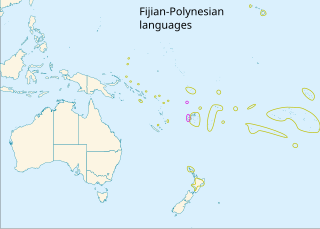
The Polynesian languages form a genealogical group of languages, itself part of the Oceanic branch of the Austronesian family.
The East Papuan languages is a defunct proposal for a family of Papuan languages spoken on the islands to the east of New Guinea, including New Britain, New Ireland, Bougainville, Solomon Islands, and the Santa Cruz Islands. There is no evidence that these languages are related to each other, and the Santa Cruz languages are no longer recognized as Papuan.

The approximately 450 Oceanic languages are a branch of the Austronesian languages. The area occupied by speakers of these languages includes Polynesia, as well as much of Melanesia and Micronesia. Though covering a vast area, Oceanic languages are spoken by only two million people. The largest individual Oceanic languages are Eastern Fijian with over 600,000 speakers, and Samoan with an estimated 400,000 speakers. The Gilbertese (Kiribati), Tongan, Tahitian, Māori and Tolai languages each have over 100,000 speakers. The common ancestor which is reconstructed for this group of languages is called Proto-Oceanic.

The Southern Oceanic languages are a linkage of Oceanic languages spoken in Vanuatu and New Caledonia. It was proposed by John Lynch in 1995 and supported by later studies. It appears to be a linkage rather than a language family with a clearly defined internal nested structure.
Malcolm David Ross is an Australian linguist. He is the emeritus professor of linguistics at the Australian National University.
Proto-Oceanic is a proto-language that historical linguists since Otto Dempwolff have reconstructed as the hypothetical common ancestor of the Oceanic subgroup of the Austronesian language family. Proto-Oceanic is a descendant of the Proto-Austronesian language (PAN), the common ancestor of the Austronesian languages.

The Madang or Madang–Adelbert Range languages are a language family of Papua New Guinea. They were classified as a branch of Trans–New Guinea by Stephen Wurm, followed by Malcolm Ross. William A. Foley concurs that it is "highly likely" that the Madang languages are part of TNG, although the pronouns, the usual basis for classification in TNG, have been "replaced" in Madang. Timothy Usher finds that Madang is closest to the Upper Yuat River languages and other families to its west, but does not for now address whether this larger group forms part of the TNG family.
The family of Northwest Solomonic languages is a branch of the Oceanic languages. It includes the Austronesian languages of Bougainville and Buka in Papua New Guinea, and of Choiseul, New Georgia, and Santa Isabel in Solomon Islands.
Ralph Neville Hermon Bulmer was a twentieth-century ethnobiologist who worked in Papua New Guinea, particularly with the Kalam people. From 1974 he made a radical shift by changing the role of his Kalam informants and collaborators, allowing them to shape the purpose of ethnography and to make them authors rather than consultants. Bulmer's tree frog is named after him.
Kalam is a Kalam language of Papua New Guinea. It is closely related to Kobon, and shares many of the features of that language. Kalam is spoken in Middle Ramu District of Madang Province and in Mount Hagen District of Western Highlands Province.

A pandanus language is an elaborate avoidance language among several of the peoples of the eastern New Guinea Highlands, used when collecting Pandanus nuts.
Moiso is an Espiritu Santo language of Vanuatu. It is spoken in Moriuli village in central Santo Island by about 100 people.
Kene is an Espiritu Santo language of Vanuatu with 300 speakers.
Daruru is an Espiritu Santo language of Vanuatu. There are perhaps 100 speakers in Pelmol village of western Santo Island.
Retlatur is an Espiritu Santo language of Vanuatu. There are about 100 speakers in Tanovusivusi village of southern Santo Island.
Atin is an Espiritu Santo language of Vanuatu. There are 120 speakers in Nambauk (Patunfarambu) and Fumatal villages of eastern Santo Island.
Farnanto is an Espiritu Santo language of Vanuatu. There are about 100 speakers in Nambauk, Tanmet, and Tafua villages of eastern Santo Island.
Fanafo is an Espiritu Santo language of Vanuatu. It is spoken by 20 people in Vanafo and Butmas villages of eastern Santo Island.
Semecarpus forstenii is a species of tree in the family Anacardiaceae. It is found in Indonesia, Papua New Guinea, and the Solomon Islands. The tree's sap is poisonous.
Ian Saem Majnep was a naturalist from the Kalam people of Papua New Guinea who wrote about the plants, animals and the belief systems of the Kalam people while collaborating with the British anthropologist and ethnobiologist Ralph Bulmer. He worked as a field assistant for Bulmer at the University of Papua New Guinea in Port Moresby and co-authored several books with Bulmer. He was also a main contributor to a dictionary of the Kalam language, which was published posthumously.



